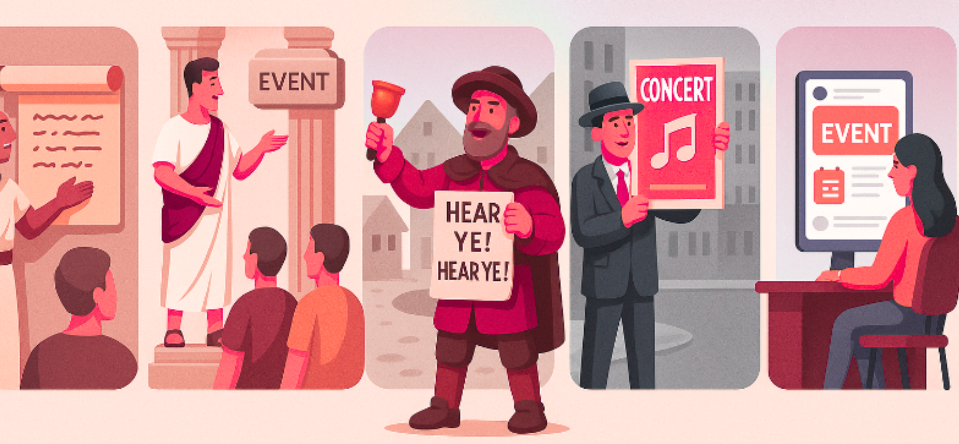Event promotion might feel like a modern marketing invention, but societies have always needed a way to spread the word when something big was about to happen. From harvest festivals to gladiator games, the art of drawing a crowd is as old as the events themselves.

Ancient Announcements: Word of Mouth and Symbols
In ancient civilizations, most “campaigns” started with the human voice. Town criers in Mesopotamia, Greece, and Rome would walk marketplaces announcing public gatherings, festivals, or political events. Roman society also pioneered what we might call the first “posters” by inscribing upcoming gladiator games and theatrical performances on walls and tablets in the Forum. Bright murals in Pompeii still show advertisements for circus shows and chariot races, complete with names of star competitors.
Medieval Festivals and Fairs
By the Middle Ages in Europe, the local fair was the centerpiece of community life. Promotion relied on the church bell tower and heralds who rode into neighboring towns declaring feast days, markets, and tournaments. Royal decrees posted on doors or read aloud in village squares gave authority to seasonal celebrations. Colorful banners and flags flown from castles or guild halls worked as visual cues, letting travelers know when a joust or merchant fair was underway.
Renaissance Spectacle and Print
The Renaissance saw event promotion become more theatrical. When Venice staged its Carnival, elaborate masks, costumes, and decorated gondolas weren’t just part of the party — they were living advertisements. Around the same time, Gutenberg’s printing press changed everything. By the 16th century, posters and broadsheets promoted festivals, theater performances, and public lectures. Shakespeare’s Globe Theatre relied heavily on printed playbills distributed across London, paired with the iconic flag raised above the theater to signal that a show was happening that day.
Industrial Revolution and the Rise of Mass Media
The 18th and 19th centuries ushered in a new era: mass events and mass promotion. Posters plastered on city walls promoted circuses like P.T. Barnum’s traveling shows, complete with illustrations of elephants and acrobats. Newspapers became a key promotional channel for concerts, operas, and political rallies. In Paris, the Impressionists even used posters designed by artists like Toulouse-Lautrec to draw attention to cabarets such as the Moulin Rouge.
The 20th Century: Radio, TV, and Billboards
By the early 20th century, promotion scaled with technology. Radio spots invited listeners to baseball games or jazz clubs. Billboards on highways promoted fairs and state exhibitions. Television transformed event marketing again, with televised ads for everything from Woodstock in 1969 to the Olympics in Los Angeles in 1984. These campaigns combined star power, visuals, and music to create cultural anticipation.
Today’s Digital Era
Now, promotion lives on screens in our pockets. That most common method being digital listings like those on Evvnt. You can superspeed that influencer with our Premium services. Social media ads, influencer partnerships, and viral countdowns on TikTok echo the same goal as town criers thousands of years ago: get people talking, get them curious, and get them to show up.
